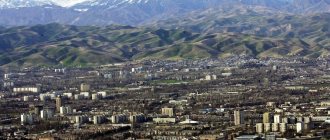Migration processes and the differences between them
The literal meaning of the concept “migration” is the movement of people from one country to another. This may concern individuals or entire national and ethnic groups moving both within individual territorial entities (internal migration) and beyond their borders (external migration).
As a rule, migrants leaving a country pursue specific goals, and according to them, migration can be classified as:
- permanent – relocation with the aim of leaving permanently for permanent residence;
- temporary - moving for a certain period of time, not related to the implementation of any activity;
- pendulum – short-term migration associated with certain goals, after the completion of which follows a return home. A prime example is individuals wishing to immigrate to obtain a job or education;
- seasonal - a short-term move associated with seasonal tasks, for example, harvesting.
Persons participating in these processes form migration flows. The direction of this flow determines the difference between immigration and emigration.
Thus, immigrants (from the Latin immigro - “I move in”) are usually called individuals who move to a foreign country for temporary or permanent residence, considered in relation to the country to which they are moving. For example, for Russians in the Russian Federation, Uzbeks are immigrants. Accordingly, Russians who moved to the United States are immigrants for Americans. That is, immigration is the entry of a foreigner into a country that is foreign to him to live in it, regardless of his goals.
An important condition is the legality of immigrants’ entry into a new country. To control immigration flows, many countries even introduce immigrant quotas.
Foreigners admitted for permanent residence usually undergo a special integration course for successful integration into the national society. The final stage of immigration is obtaining citizenship of your new country.
Emigration is a concept of a different, opposite nature. The definition of emigration comes from the Latin emigro - “moving out”. It means leaving the country and moving to another state other than your native one. It should not be confused with short-term trips; emigration is always associated with a change of place of residence, although sometimes on a temporary basis. Such relocation does not at all mean a mandatory change of citizenship. For example, Russia allows its citizens to have several other passports, especially if they live outside the Russian Federation.
Hence, an emigrant is a person who leaves the country of his citizenship. Please note that, unlike immigro, emigration cannot be internal - this process involves mandatory crossing of the state border in order to move to a new place of residence abroad.
Emigration is usually caused by the search for a better, more economically favorable place to live, which is why it usually prevails over immigration in undeveloped countries. In the prosperous, the opposite is true.
Therefore, in order to determine which is correct: immigration or emigration, it is important to understand in relation to which state this concept applies. So, if we are talking about the country from which a person is leaving, the concept of “emigrant” is used, and the process itself is called emigration. The migrant will be an immigrant in relation to the state to which he is moving, and the process itself will be called immigration.
It is important to understand that the difference between migration and emigration is insignificant. Thus, migration is the process of moving in general, and emigration, like immigration, is the direction of the migration flow in relation to a particular country.
Forms of migration
One of the most common forms of migration is labor. It is divided into two separate types:
- Internal - occurring within the borders of one state;
- International migration is when a person moves to another country to find work.
Read also: Illegal registration in an apartment
In turn, such labor migration has two aspects: negative and positive. Among the positive aspects of changing your place of residence for employment are:
- Reducing the total amount of expenses in the home country for maintaining migrants;
- Migrant workers provide an influx of funds, most of which goes to families remaining in their home country;
- Increase in the number of jobs.
Among the negative aspects of migration are:
- The outflow of specialists, which subsequently leads to a shortage of personnel;
- The fact of illegal migration, which entails a decrease in the level of security in the country and an increase in unemployment;
- Reduction in the number of jobs in the country where the migrant worker came.
In most cases, labor migration is viewed solely as a negative phenomenon, so many countries seek to resolve this problem on their own. For example, this may be due to the fact that a large number of low-skilled workers are constantly entering the state and at the same time there is an outflow of specialists.
What makes people migrate
Migration processes are always caused by similar circumstances. Internal relocation is usually due to improved living conditions, changes in lifestyle, or change of place of work; this is typical for territories with diverse natural, climatic, social, economic and other conditions.
International relocation is most often based on economic migration:
- higher salary for the same job;
- labor shortage;
- favorable business climate;
- attracting highly qualified specialists from certain industries;
- desire to provide the family with a decent standard of living.
Economic motives also occupy a central place when leaving the country. But along with them, there are other reasons for emigration:
- high unemployment and economic instability;
- unstable political situation and social unrest;
- religious, racial and other persecution;
- armed conflicts;
- family reunion abroad;
- participation in repatriation programs for compatriots living abroad, and so on.
Re-emigration is an integral part of immigration
Very illustrative are such examples of immigration as the return of emigrants to their homeland, as well as the resettlement of citizens of foreign countries with signs of national identity. These processes are called re-emigration and repatriation, respectively. These are similar concepts that are components of migration, but it is important to distinguish them.
Which country would you rather live in? ⚡ Take the test in 2 minutes
Re-emigration is a process in which migrants who previously left the country of their citizenship return to their homeland. Usually this applies only to persons who have retained citizenship, because after its loss it is logical to apply the concept of “immigration”.
Re-emigration is also typical for Russia: the largest influx of re-emigrants was observed in the 90s, after the collapse of the Soviet Union, dissidents, intellectuals, and others who emigrated to the USA, Israel and other countries returned to the country. In addition to them, thousands of Russian Germans who moved to Germany between 1990 and 2011 as late migrants returned to their homeland.
Repatriation, on the contrary, is the immigration of a population that has never been citizens of the country, but has signs of national identity, and therefore moves to the homeland of their ancestors. An important condition for repatriation is the presence in the migration legislation of the state where they are resettling, appropriate immigration programs that allow repatriates to move to the country on preferential terms.
For example, late migrants from the Russian Federation and other CIS countries, if they have evidence of German origin, have the right to move to Germany, immediately obtain a residence permit and obtain citizenship.
There are similar programs in Russia. For example, compatriots living abroad, within the framework of the Resettlement of Compatriots Program, can choose a region of the Russian Federation from 48 territories of priority settlement, and when moving to it receive many benefits and even a one-time amount of assistance up to 240 thousand rubles per applicant and 120 thousand rubles per member his family.
In addition to federal assistance, immigrants can also apply for regional forms of support. They immediately receive a residence permit, after which they can receive citizen status under a simplified program.
Repatriation is an important component of migration processes. For example, under the Compatriots Resettlement Program, from 2007 to 2017, 656 thousand foreigners with Russian roots returned to Russia, most of whom (39%) are Ukrainians.
Content
- 1 Reasons for immigration
- 2 Types of immigration
- 3 History
- 4 Present tense
- 5 Immigration by country 5.1 Immigration to Australia
- 5.2 Immigration to the US
- 5.3 Immigration to Germany
- 5.4 Immigration to Spain
- 5.5 Immigration to France
- 5.6 Immigration to the UK
- 5.7 Immigration to Norway
- 5.8 Immigration to the Benelux countries
- 5.9 Immigration to Japan
- 5.10 Immigration to Montenegro
- 5.11 Immigration to Russia
How to travel to another country
There is only one answer to the question of where to start immigration - by finding a reason to move. They may be the presence of relatives or potential spouses abroad, employment with a foreign employer, education abroad, the presence of foreign roots, the presence of real estate, or, for example, the desire to conduct business in a particular country.
If there is such a potential connection with the desired state, then the immigration process can begin. It includes the following steps:
- Applying for a national visa at the country’s visa center or its diplomatic mission.
- Entry into the country during the validity period of the visa.
- Submitting an application for a residence permit. The basis for a residence permit is usually the purpose for which the visa was issued.
- Preservation of the grounds on which entry was carried out and, in connection with this, extension of the residence permit.
- Long-term residence and obtaining permanent residence.
- Obtaining national citizenship.
The length of the process will depend on the specifics of the situation and the provisions of national legislation. All this can take from 2-3 to 10 years; The Russian Federation provides a simplified scheme for some categories of migrants - according to it, citizenship can be obtained in 4-6 months.
Links
| Population immigration at Wikimedia Commons |
| Immigration in Wikinews |
- Immanuel Wallerstein
. Immigration: protest against protest? - Articles about immigration from the Demoscope website
- Isaac Gurvich
, Immigration and Labor: The Economic Aspects of European Immigration to the United States, (English) (New York, 1912) - Christiano Codagnone.
Experience of Italian immigration policy. 2004
Where to move from Russia
Considering the peculiarities of life in our country, most emigrants are guided primarily by economic motives. Few people seek to move from Russia, for example, to African countries or the Middle East; Russians are interested in more prosperous destinations.
It is expected that in 2021 the most Russians will move to:
- USA - entire Russian districts in large cities, many compatriots and a developed network of diasporas await them;
- The EU countries are the most popular among Russians: Germany, Czech Republic, Poland, Finland and Spain. About a third of all emigrants from Russia move to Europe;
- Israel - national legislation gives Jews the right to return to the Promised Land, as a result of which about 5 thousand people of Jewish nationality leave Russia annually;
- Quebec (Canada) - Russians come here who could not find the American dream in the USA.
- China is a friendly country for Russians; many move here to do business and stay forever.
In addition to foreign countries, many Russians move to nearby ones, in particular, Belarus, Ukraine, Kazakhstan, Lithuania and Latvia. This is usually due to family reasons.
Integration of immigrants
The Netherlands began formulating integration policies back in 1979. Television channels broadcasting in the languages of national minorities appeared, the teaching of immigrant languages was introduced, and teachers were trained to teach classes in their languages. Similar events were later held in other European countries. Multiculturalism was declared official policy. However, this policy has been criticized.
There are different points of view on the question of whether immigrant children should study in the same classrooms as local children upon arrival. Among local children, foreign children learn the language faster, but their presence there may slow down other students. In special classes for foreigners, children calmly learn the local language; each child has their own program, but they have no contact with local peers, which does not contribute to learning the local language.
Now almost all European countries provide additional funding to schools where children of immigrants study. France began to use the concept of “problem schools” back in 1982 and allocate additional funding for them. Germany only started doing this in 2007. Additional funds allocated go towards additional education for teachers and expansion of the teaching staff with specialists and assistants who speak children’s languages. Student mentors from immigrant backgrounds are actively used to help immigrant children. However, many migrant children still end up in schools below their level, in special schools or in classes inappropriate for their age. All this hinders their development and reduces their employment prospects. Problems are also created by the fact that in some schools there are significantly more children of non-European origin than local ones.[3]







